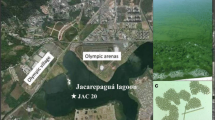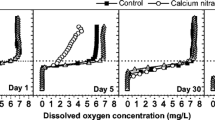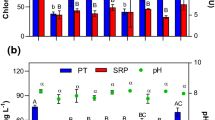Abstract
Phoslock™ is a specially modified clay designed to permanently bind phosphorus in those situations where phosphorus (P) release from sediments is a main driver of algal bloom formation. Extensive laboratory and mesocosm trials have demonstrated the effectiveness of Phoslock™ in binding sediment released P using less than a millimetre thickness of clay. Two full-scale applications were undertaken in the summer of 2001/2002 in the impounded riverine section of two estuaries along the coastal plain of south west Western Australia. Both rivers are subject to blue-green algal blooms in the summer months. Phoslock™ applied in a slurry from a small boat reduced dissolved P in the water column to below detection limit in the few hours it took for the clay to settle and substantially reduced P efflux from the sediments during the course of the trial. The effect of P reduction on phytoplankton growth was clearly evident in the phytoplankton dominated Vasse River but was less clear in the alternating phytoplankton to aquatic plant dominated Canning River which is also subject to surface nutrient inputs.
Similar content being viewed by others
References
Douglas, G. B. & J. A. Adeney, 2001. 2000 Canning River PhoslockTM trial. Confidential report prepared for Water and Rivers Commission. CSIRO Land and Water Report January, 2001: 75 pp.
Douglas, G. B. & D. N. Coad, 1997. Review of estuarine sediment remediation techniques. Confidential Report prepared for Water and Rivers Commission. CSIRO Division of Water Resources Report (96-11). 81 pp. Revised October, 1997: 96 pp.
Douglas, G. B., J. A. Adeney & M. S. Robb, (1999). A novel technique for reducing bioavailable phosphorus in water and sediments. International Association Water Quality Conference on Diffuse Pollution: 517-523.
Greenop B., K. Lovatt & M. Robb, 2001. The use of artificial oxygenation to reduce nutrient availability in the Canning River, Western Australia. Wat. Sci. Technol. 43(9): 133-144.
Harris, G. P., 1997. Algal biomass and biogeochemistry in catchments and aquatic ecosystems: scaling of processes, models and empirical tests. Hydrobiologia 349: 19-26.
Hart, B. & M. Grace, 2000. Nitrogen Workshop 2000: Sources, transformations, effects and management of nitrogen in freshwater ecosystems. CSIRO Land and Water Australia. Occasional Paper 10/00.
Jones, G. J., 1994. Bloom forming Blue Green Algae (Cyanobacteria). In Sainty, G. & S. Jacobs (eds), Aquatic Plants of Australia. Sainty and Associates, Sydney NSW: 264-285.
Moss, B., 1990. Engineering and biological approaches to the restoration from eutrophication of shallow lakes in which aquatic plant communities are important components. Hydrobiologia 200/201: 367-377.
Thompson, P. A., 1998. Spatial and temporal factors influencing phytoplankton in a salt wedge estuary, the Swan River, Western Australia. Estuaries 21: 801-887.
Thompson. P. A., A. Waite & K. McMahon, Dynamics of a cyanobacterial bloom in a hypereutrophic, stratified weir pool.Mar. Freshwat. Res. (in press).
Vincent, W. J., 2001. Nutrent partitioning in the upper Canning River, Western Australia, and implications for the control of cyanobacterial blooms using salinity. Ecol. Eng. 16: 359-371.
Author information
Authors and Affiliations
Rights and permissions
About this article
Cite this article
Robb, M., Greenop, B., Goss, Z. et al. Application of PhoslockTM, an innovative phosphorus binding clay, to two Western Australian waterways: preliminary findings. Hydrobiologia 494, 237–243 (2003). https://doi.org/10.1023/A:1025478618611
Issue Date:
DOI: https://doi.org/10.1023/A:1025478618611




